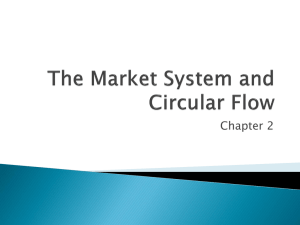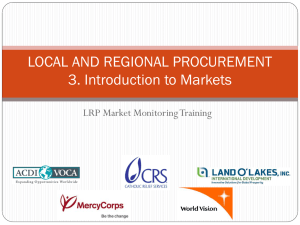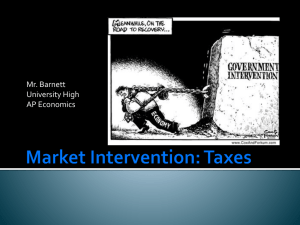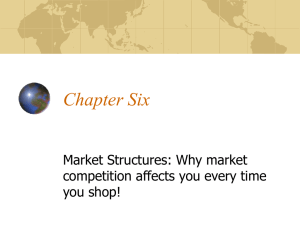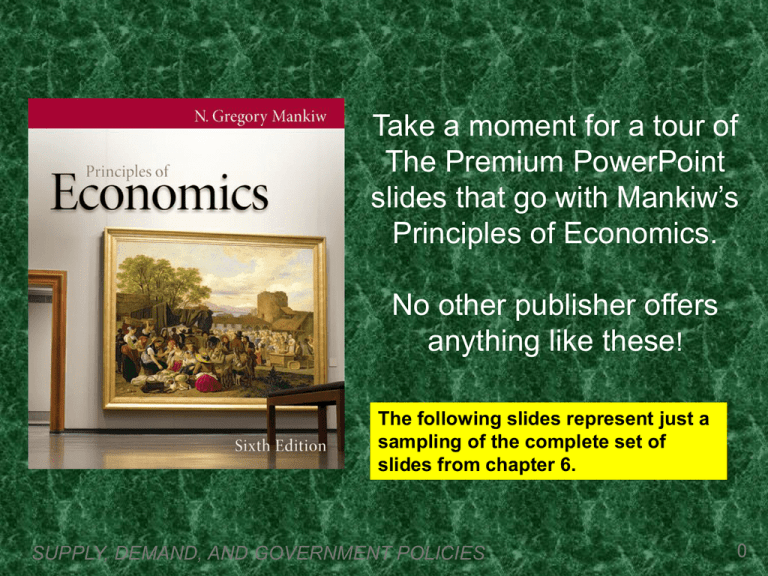
Take a moment for a tour of
The Premium PowerPoint
slides that go with Mankiw’s
Principles of Economics.
No other publisher offers
anything like these!
The following slides represent just a
sampling of the complete set of
slides from chapter 6.
SUPPLY, DEMAND, AND GOVERNMENT POLICIES
0
CHAPTER
6
We
HaveWe
PowerPoints
Have Great
of all the We
Exhibits
in Have
Also
theTraditional
Text!
Again,
Big Deal!
Big
Deal!
So Does
Everybody
Has
Everybody!
That!
OK, I’m Game.
What Are
Premium
PowerPoints?
Supply,
Demand,
and
Premium
PowerPoints
PowerPoints
Too!
by Ron Cronovich.
Government
Policies
Nobody Has Anything Like
Economics
THESE!
PRINCIPLES
One of the leading
experts on the use of
PowerPoint in the
classroom
OF
N. Gregory Mankiw
Premium PowerPoint Slides
by Ron Cronovich
© 2010 South-Western, a part of Cengage Learning, all rights reserved
Updated
Every
Year!
2010
update
Teaching Notes
for Each Slide
SUPPLY, DEMAND, AND GOVERNMENT POLICIES
2
Every slide comes with
Explanations and teaching
Tips for the instructor
SUPPLY, DEMAND, AND GOVERNMENT POLICIES
3
More examples of the
Teaching Notes for
each slide
SUPPLY, DEMAND, AND GOVERNMENT POLICIES
4
You can make Student Prompt
Notes available to your class.
These allow students to take notes
On partially completed graphs.
They do not have to re-create the
entire graph, but they still need to
come to class to fill in the gaps.
SUPPLY, DEMAND, AND GOVERNMENT POLICIES
5
EXAMPLE 2: The Market for Unskilled Labor
Wage
paid to
unskilled
workers
Eq’m w/o
price
controls
W
S
$4
Walk-Throughs of
a Number of
Complete
Examples for the
Chapter500
D
L
Quantity of
unskilled workers
SUPPLY, DEMAND, AND GOVERNMENT POLICIES
6
How Price Floors Affect Market Outcomes
A price floor
below the
eq’m price is
not binding –
has no effect
on the market
outcome.
W
S
$4
Price
floor
$3
D
500
SUPPLY, DEMAND, AND GOVERNMENT POLICIES
L
7
How Price Floors Affect Market Outcomes
The eq’m wage ($4)
is below the floor
and therefore
illegal.
The floor
is a binding
constraint
on the wage,
causes a
surplus (i.e.,
unemployment).
W
labor
surplus S
Price
floor
$5
$4
D
400
SUPPLY, DEMAND, AND GOVERNMENT POLICIES
550
L
8
The Minimum Wage
Min wage laws
do not affect
highly skilled
workers.
They do affect
teen workers.
Studies:
A 10% increase
in the min wage
raises teen
unemployment
by 1-3%.
W
unemployment S
Min.
wage
$5
$4
D
400
SUPPLY, DEMAND, AND GOVERNMENT POLICIES
550
L
9
ACTIVE LEARNING
Price controls
P
140
Determine
effects of:
1
The market for
hotel rooms
130
S
120
110
A. $90 price Active
100 Learning PowerPoints
ceiling
Allow
90 you to get students
B. $90 price
floor
C. $120 price
floor
engaged
in class by asking
80
them questions and
70
demonstrating
the results
D
60
50
40
0
Q
50 60 70 80 90 100 110 120 130
10
ACTIVE LEARNING
1
A. $90 price ceiling
The price
falls to $90.
P
140
The market for
hotel rooms
S
130
120
Buyers
demand
120 rooms,
sellers supply
90, leaving a
shortage.
110
100
90
80
Price ceiling
D
shortage = 30
70
60
50
40
0
Q
50 60 70 80 90 100 110 120 130
11
ACTIVE LEARNING
B. $90 price floor
Eq’m price is
above the floor,
so floor is not
binding.
P = $100,
Q = 100 rooms.
P
140
1
The market for
hotel rooms
130
S
120
110
100
90
80
Price floor
D
70
60
50
40
0
Q
50 60 70 80 90 100 110 120 130
12
ACTIVE LEARNING
C. $120 price floor
The price
rises to $120.
Buyers
demand
60 rooms,
sellers supply
120, causing a
surplus.
P
140
130
120
110
1
The market for
hotel rooms
surplus = 60
S
Price floor
100
90
80
D
70
60
50
40
0
Q
50 60 70 80 90 100 110 120 130
13
Evaluating Price Controls
Recall one of the Ten Principles from Chapter 1:
Markets are usually a good way
to organize economic activity.
Prices are the signals that guide the allocation of
society’s resources. This allocation is altered
when policymakers restrict prices.
Price controls often intended to help the poor,
but often hurt more than help.
SUPPLY, DEMAND, AND GOVERNMENT POLICIES
14
EXAMPLE 3: The Market for Pizza
Eq’m
w/o tax
P
S1
$10.00
The Next Few Slides
will show you the
walk through of a
complete example
D1
500
SUPPLY, DEMAND, AND GOVERNMENT POLICIES
Q
15
A Tax on Buyers
The
price
buyers
pay
Hence,
a tax
on buyers
is
nowthe
$1.50
higher
than
shifts
D curve
down
the
market
price
by the
amount
ofP.
the tax.
Effects of a $1.50 per
unit tax on buyers
P
P would have to fall
by $1.50 to make
$10.00
buyers willing
to buy same Q
as before.
$8.50
E.g., if P falls
from $10.00 to $8.50,
buyers still willing to
purchase 500 pizzas.
SUPPLY, DEMAND, AND GOVERNMENT POLICIES
S1
Tax
D1
D2
500
Q
16
A Tax on Buyers
New eq’m:
Effects of a $1.50 per
unit tax on buyers
Q = 450
Sellers
receive
PS = $9.50
Buyers pay
PB = $11.00
P
PB = $11.00
S1
Tax
$10.00
PS = $9.50
Difference
between them
= $1.50 = tax
SUPPLY, DEMAND, AND GOVERNMENT POLICIES
D1
D2
450 500
Q
17
The Incidence of a Tax:
how the burden of a tax is shared among
market participants
In our
example,
buyers pay
$1.00 more,
P
PB = $11.00
S1
Tax
$10.00
PS = $9.50
sellers get
$0.50 less.
D1
D2
450 500
SUPPLY, DEMAND, AND GOVERNMENT POLICIES
Q
18
A Tax on Sellers
The tax effectively raises
sellers’ costs by
P
$1.50 per pizza.
$11.50
Sellers will supply
500 pizzas
only if
P rises to $11.50,
to compensate for
this cost increase.
Effects of a $1.50 per
unit tax on sellers
S2
Tax S1
$10.00
Hence, a tax on sellers shifts the
S curve up by the amount of the tax.
SUPPLY, DEMAND, AND GOVERNMENT POLICIES
D1
500
Q
19
A Tax on Sellers
New eq’m:
Effects of a $1.50 per
unit tax on sellers
Q = 450
Buyers pay
PB = $11.00
Sellers
receive
PS = $9.50
P
PB = $11.00
S2
S1
Tax
$10.00
PS = $9.50
Difference
between them
= $1.50 = tax
SUPPLY, DEMAND, AND GOVERNMENT POLICIES
D1
450 500
Q
20
The Outcome Is the Same in Both Cases!
The effects on P and Q, and the tax incidence are the
same whether the tax is imposed on buyers or sellers!
What matters
is this:
A tax drives
a wedge
between the
price buyers
pay and the
price sellers
receive.
P
PB = $11.00
S1
Tax
$10.00
PS = $9.50
SUPPLY, DEMAND, AND GOVERNMENT POLICIES
D1
450 500
Q
21
CASE STUDY: Who Pays the Luxury Tax?
1990: Congress adopted a luxury tax on yachts,
private airplanes, furs, expensive cars, etc.
Walk Through a
Goal of the tax: raise
revenue
from
those
Case Study
who could most easily afford to pay –
wealthy consumers.
But who really pays this tax?
SUPPLY, DEMAND, AND GOVERNMENT POLICIES
22
CASE STUDY: Who Pays the Luxury Tax?
The market for yachts
P
Buyers’ share
of tax burden
Demand is
price-elastic.
S
In the short run,
supply is inelastic.
PB
Tax
Sellers’ share
of tax burden
PS
D
Q
SUPPLY, DEMAND, AND GOVERNMENT POLICIES
Hence,
companies
that build
yachts pay
most of
the tax.
23
CONCLUSION: Government Policies and
the Allocation of Resources
Each of the policies in this chapter affects the
allocation of society’s resources.
Example 1: A tax on pizza reduces eq’m Q.
With less production of pizza, resources
(workers, ovens, cheese) will become available
to other industries.
Example 2: A binding minimum wage causes
a surplus of workers, a waste of resources.
So, it’s important for policymakers to apply such
policies very carefully.
SUPPLY, DEMAND, AND GOVERNMENT POLICIES
24
3 Types of PowerPoints for
Mankiw
1. Exhibit
2. Traditional
3. Premium
The Most Extensive Set of
PowerPoints available for any text.
You can download them now through
The instructor resource site.
SUPPLY, DEMAND, AND GOVERNMENT POLICIES
25





